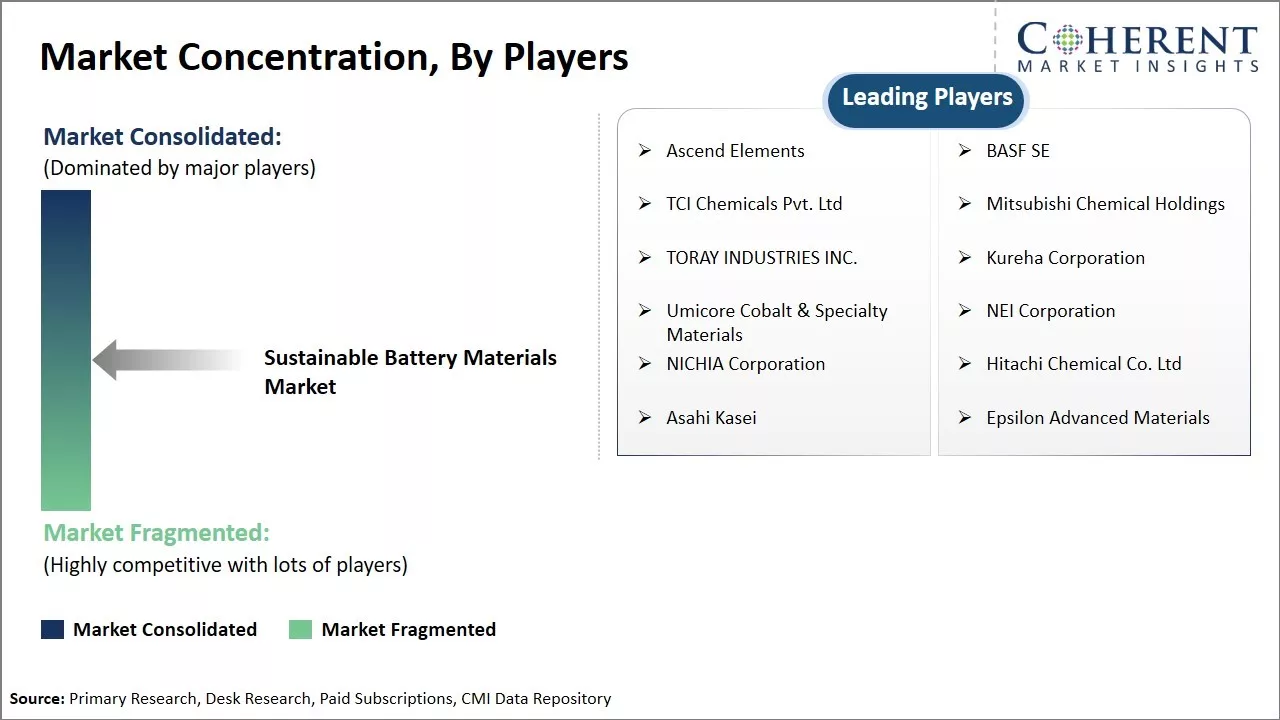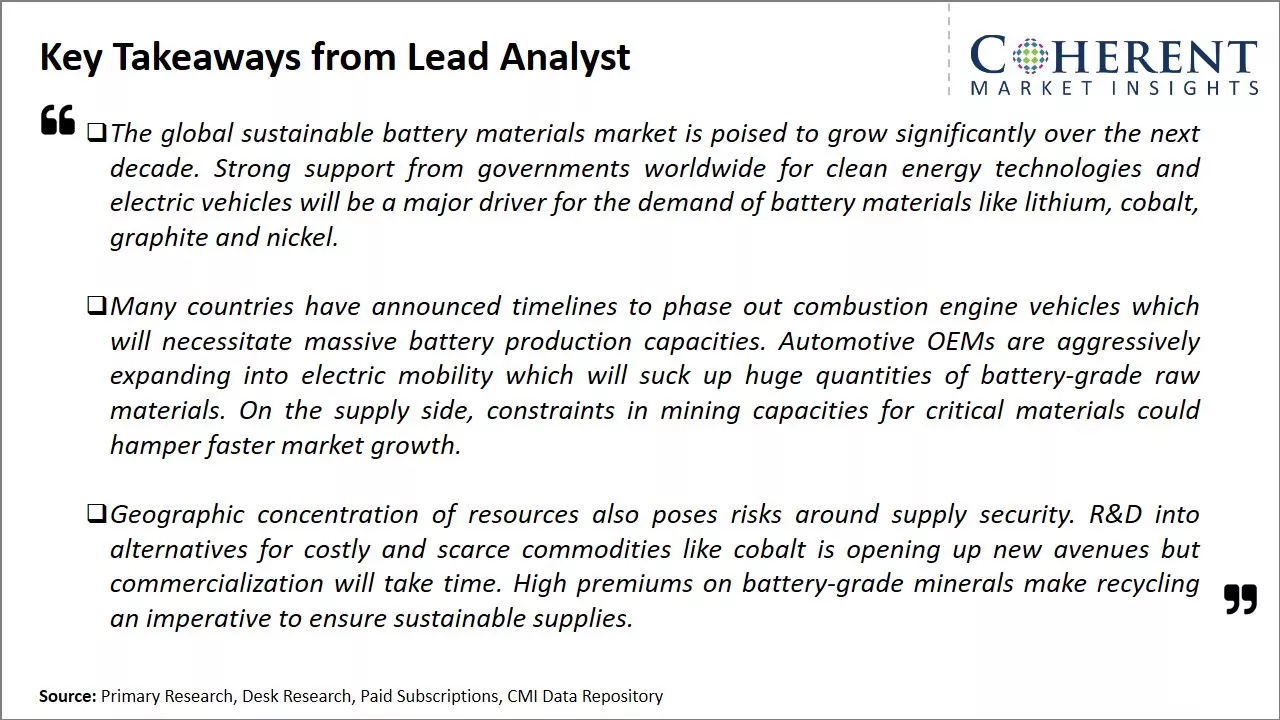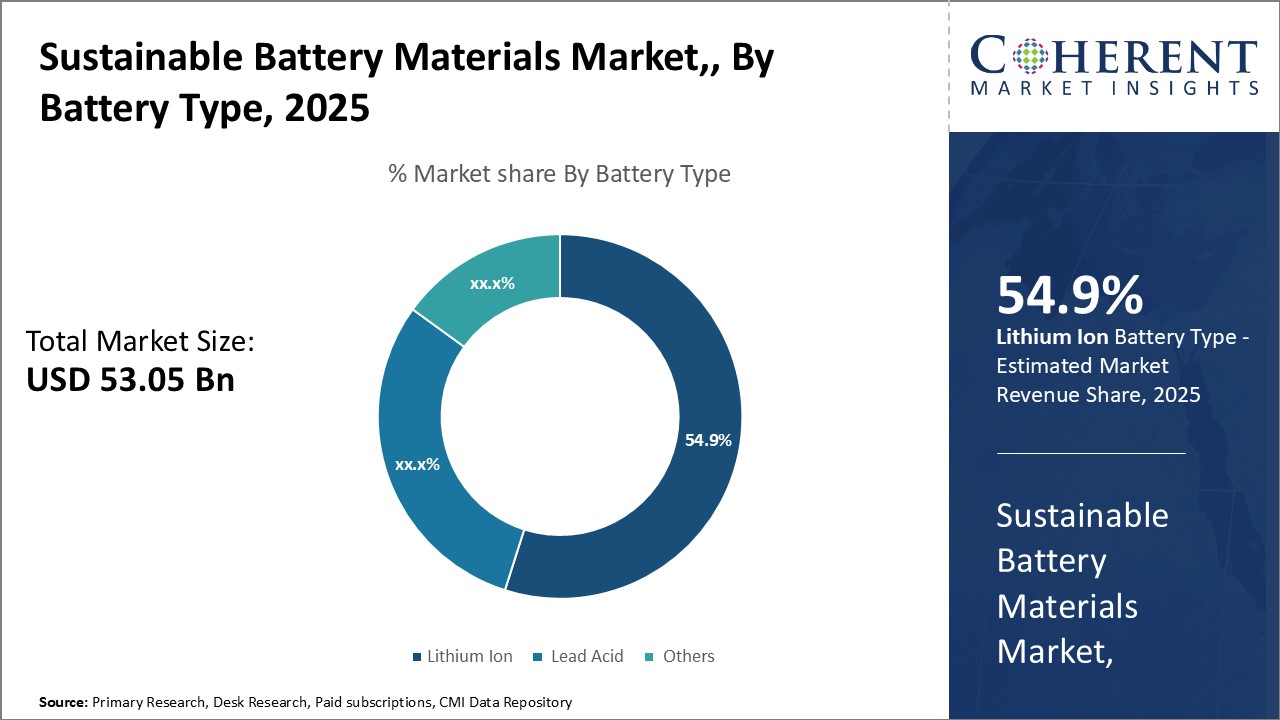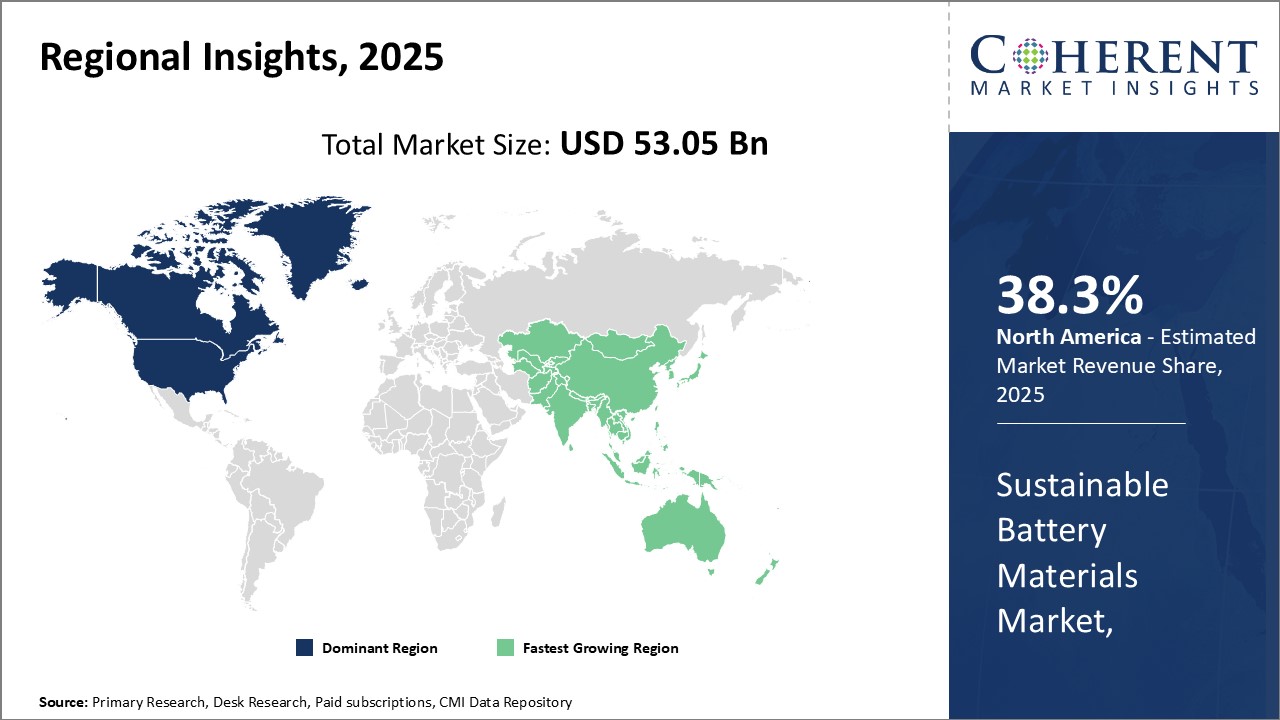Sustainable Battery Materials Market, Size and Trends
Global sustainable battery materials market is estimated to be valued at USD 53.05 Bn in 2025 and is expected to reach USD 81.95 Bn by 2032, exhibiting a compound annual growth rate (CAGR) of 6.4% from 2025 to 2032.

Discover market dynamics shaping the industry: Download Free Sample
Global sustainable battery materials market is expected to witness strong growth over the forecast period due to factors such as increasing demand for electric vehicles and government mandates and regulations requiring more sustainable materials in batteries to minimize environmental impact. Major automotive OEMs are actively focusing on developing batteries with sustainable materials to further reduce carbon footprint. Battery material manufacturers are also relentlessly working on identifying new sustainable alternatives to conventionally used materials. New product development and capacity expansion strategies adopted by market players are expected to further boost the adoption of sustainable battery materials. However, high initial investments and limited availability of raw materials can hamper the growth of the market during the forecast period.
Electric Vehicles Driving Demand
Rising adoption of electric vehicles across the globe can drive the market growth. As EVs are shifting from niche to mainstream market, an increasing number of auto manufacturers are committing huge investments to meet the surge in demand. These are aggressively launching new EV models and ramping up their production capacities. This rising EV production and sales boosts need for large volumes of sustainable battery materials like lithium, cobalt, graphite and others. Most experts predict that EVs will dominate auto sales in the coming decade due to favorable government policies and regulations regarding emission norms. Various countries have announced plans to phase out internal combustion engine vehicles and switch to zero-emission EVs in the near future. This encourages more consumers to opt for electric cars, and is expected to scale up the battery materials demand manifolds. Battery chemistries are advancing quickly to boost vehicles' driving range on a single charge. The transition to newer battery chemistries can offer opportunities for alternative anode and cathode materials manufacturers. The electrification of transport sector is expected to boost consumption of sustainable battery materials.
Market Concentration and Competitive Landscape

Get actionable strategies to beat competition: Download Free Sample
Focus on Clean Energy TransitionThe global transition towards sustainability and clean energy is driving significant growth in the battery materials market. With worldwide ambitions to curb greenhouse gas emissions and expand the use of renewable energy sources, batteries are seen as a key enabling technology to support these goals. Batteries allow surplus power from solar and wind farms to be stored and used when natural generation is low, and are powering more electric vehicles on the road which produce zero direct emissions. Countries and corporations around the world have announced aggressive targets and investments in clean energy and electric transportation infrastructure. For example, the EU has committed to fitting 30 million zero-emission vehicles on European roads by 2030 through its ‘Fit for 55’ package. In the US, the Biden administration aims to make half of all new vehicles sold in 2030 zero-emissions, including battery electric, fuel cell and plug-in hybrid vehicles. To support these ambitious targets, battery material supply chains must rapidly scale up. Metals such as lithium, cobalt, nickel and manganese will be in high demand for battery cathodes. Other materials like graphite, separators and electrolytes will also see increased needs.

To learn more about this report, Download Free Sample
Challenge: High Investment costs for battery material productionThe high initial investment costs required for the production of sustainable battery materials is a major factor restraining the growth of the global sustainable battery materials market. Producing battery materials in an environmentally sustainable way necessitates setting up production facilities that adhere to stringent emission norms and carbon footprint standards. This involves deploying advanced manufacturing technologies and processes that are more capital intensive compared to traditional methods. For instance, building a lithium-ion battery gigafactories with an annual production capacity of 35 GWh would require an estimated investment of over USD 5 billion. Similarly, sustainable production of other critical materials like cobalt, nickel and graphite also entails higher costs for sourcing, development of supply chains and deployment of carbon capture systems.
Opportunity: Growing markets for electric vehicles, consumer electronics and energy storage
The growing demand for electric vehicles, consumer electronics and energy storage solutions across the globe presents a massive opportunity for the sustainable battery materials market. With the negative environmental impact of combustion engines coming under rising scrutiny, many countries are incentivizing the adoption of electric vehicles to reduce carbon emissions from the transport sector. Several nations have announced plans to transition entirely to electric vehicles in the coming decades. For instance, the UK government has proposed to ban the sale of new petrol and diesel cars by 2030. This is expected to drastically boost the demand for lithium-ion batteries for electric vehicles. At the same time, consumer electronics such as smartphones, laptops and wearables have become an integral part of everyday life. As people replace their devices more often and adopt new technologies like foldable phones, the consumption of lithium-ion batteries for consumer devices is projected to grow exponentially. Rapid improvements in energy storage solutions will also be critical for integrating more renewable energy into national power grids. With more households and businesses installing rooftop solar panels, the market for battery packs to store this green energy is poised for strong growth. All these factors indicate surging future requirements for raw materials used to manufacture advanced lithium-ion batteries including lithium, cobalt, graphite, nickel and manganese among others.

Discover high revenue pocket segments and roadmap to it: Download Free Sample
Insights, By Battery Type: Growing demand for high energy density and long life drives the lithium-ion segment growthIn terms of battery type, lithium ion segment is estimated to contribute the 54.9% share of the market in 2025, owing to several key advantages it offers over other battery technologies. Lithium-ion batteries deliver high energy density, thus, these can store more electricity in a smaller and lighter package as compared to other battery types like lead-acid. This makes lithium-ion the preferred choice for applications where space and weight are constrained, such as consumer electronics and electric vehicles. Another major advantage is that lithium-ion batteries does not experience the memory effect like nickel-based batteries. This allows lithium-ion to be partially charged without reducing the battery's maximum capacity over time. The lack of memory effect coupled with high energy density means devices can be powered for longer between charges. This longevity of usable life is crucial for the consumer, as it directly impacts the overall cost of ownership. Lithium-ion batteries are also more environmentally friendly than other battery technologies. These do not use heavy metals like mercury or cadmium that are toxic and difficult to dispose of safely. Lithium is also one of the most abundant metals in the Earth's crust, thus, providing a sustainable raw material source. These green credentials have helped drive broader adoption of lithium-ion across various industries aiming to reduce their environmental footprint. Ongoing research and development is further enhancing lithium-ion technology. New cathode and anode materials are enabling higher voltage and energy density with each iteration. Major players are also optimizing chemistries for improved safety features to address lithium-ion's vulnerability to overheating.
Insights, By Material: Growing electrification of transport boosts demand for cathode
In terms of material, cathode segment is estimated to contribute the 38.1% share of the market in 2025, owing to its critical role in lithium-ion batteries. The cathode is one of two electrodes that is used to extract and restore chemical energy during the charging and discharging process. Advanced cathode materials with a high energy density are essential to meet the rigorous power and range requirements of electric vehicles (EVs). The automotive industry has emerged as the single largest end user of lithium-ion batteries to fuel the burgeoning EV market. In response, leading automakers have committed massive investments towards electric vehicle development and production. This large-scale industry transition will sustainably boost cathode consumption in the near future. Suppliers must gear up to deliver high-performance, cost-competitive materials to automakers amid this period of intensive change and growth.
Insights, By Application: Expanding consumer electronics drive anode innovation
In terms of application, consumer electronics segment is estimated to contribute the 38.3% share of the market in 2025due to the ubiquitous use of lithium-ion batteries. Lithium-ion excels at powering the myriad of portable devices people rely on daily, from phones to laptops. Device manufacturers in this sector face immense pressure to continuously miniaturize form factors while extending battery life and capabilities. This drives intense focus on anode chemistries, as the anode represents one of the largest opportunities for energy density and lifespan improvements through material innovation. Companies are actively developing graphene-enhanced and silicon-based anodes with up to 2-3x the energy density of conventional graphite. These new materials can not only satisfy consumers' constant demand for longer usage per charge, but also enable smaller, lighter devices. Such form factor optimizations are critical for consumer electronics vendors aiming to maintain competitive differentiation in this highly innovative marketplace. Much research also focuses on stabilizing volume expansion issues that have historically plagued high-capacity silicon and lithium-metal anodes. Solutions could greatly extend battery lifetimes and number of charge cycles - another must-have for consumer electronics consumers accustomed to multi-year device lifespans.
Regional Insights

Need a Different Region or Segment? Download Free Sample
North America remains the dominant leader in the global sustainable battery materials market with estimated 38.3% share in 2025. The region has a strong presence of major battery material manufacturers, several R&D centers and a robust supply chain network, thus, allowing it to cater to the growing domestic demand. The U.S., being a pioneer in industrialization and technology, also has favorable government policies supporting battery innovation. It is a hub for manufacturing lithium-ion battery chemistries that are key to powering electronics and EVs. Several battery gigafactories are also being set up in the region by top players to ensure supply security. Imports of battery-grade raw materials like lithium, cobalt and graphite are high to bridge the gap between local availability and production needs. However, recycling programs are being strengthened to improve resource security and manage e-waste in an environmentally responsible manner.
Asia Pacific has emerged as the fastest growing regional market in recent years and is expected to sustain this momentum. China, with its large electronics market and push for new energy vehicles, has become the global production capital for lithium-ion batteries. The country hosts a significant number of cathode and anode material manufacturing facilities. South Korea and Japan also have a sizable presence across the battery manufacturing value chain. Investments are increasing in these countries to expand capacities of advanced lithium-rich nickel-manganese-cobalt (NMC) type cathode chemistries. The availability of raw materials, low production costs and focus on deploying batteries locally are driving regional demand. Several Southeast Asian nations are also trying to gain a foothold in the global supply chain by developing their mining and recycling sectors. This will help meet the accelerated requirements from the EV and energy storage industries.
Market Report Scope
Sustainable Battery Materials Market Report Coverage
| Report Coverage | Details | ||
|---|---|---|---|
| Base Year: | 2024 | Market Size in 2025: | USD 53.05 Bn |
| Historical Data for: | 2020 To 2024 | Forecast Period: | 2025 To 2032 |
| Forecast Period 2025 to 2032 CAGR: | 6.4% | 2032 Value Projection: | USD 81.95 Bn |
| Geographies covered: |
|
||
| Segments covered: |
|
||
| Companies covered: |
Ascend Elements, BASF SE, TCI Chemicals Pvt. Ltd, Mitsubishi Chemical Holdings, TORAY INDUSTRIES INC., Kureha Corporation, Umicore Cobalt & Specialty Materials, NEI Corporation, NICHIA Corporation, Hitachi Chemical Co. Ltd, Asahi Kasei, Epsilon Advanced Materials |
||
| Growth Drivers: |
|
||
| Restraints & Challenges: |
|
||
Uncover macros and micros vetted on 75+ parameters: Get instant access to report
Sustainable Battery Materials , Industry News
- In February 2024, Ascend Elements raised additional USD 162 Million to build sustainable lithium-ion battery materials in U.S.
- In March 2024, Aqua Metals and 6K Energy partnered to create North America's first sustainable circular supply chain for lithium battery materials
- In April 2024, Green Li-ion launched North America's first commercial-scale sustainable battery materials plant. Green Li-ion, a lithium-ion battery recycling Technology Company, announced the launch of its first commercial-scale installation to produce sustainable, battery-grade materials, the first of its kind in North America.
- In December 2023, RecycLiCo Battery Materials Inc. and Nanoramic partnered to optimize the life cycle of lithium-ion batteries
*Definition: Global Sustainable Battery Materials Market consists of companies that provide battery materials and components used in lithium-ion batteries that are sourced and processed in a sustainable and environmentally responsible manner. This includes materials like lithium, cobalt, graphite, nickel and manganese that are extracted via ethical mining practices with low environmental impact. It also involves companies focusing on recycled and secondary materials to manufacture batteries, as well as those developing innovative chemistries and engineering designs that allow for greener and more sustainable battery production.
Market Segmentation
- Battery Type Insights (Revenue, USD Bn, 2020 - 2032)
- Lithium Ion
- Lead Acid
- Others
- Material Insights (Revenue, USD Bn, 2020 - 2032)
- Cathode
- Anode
- Electrolyte
- Others
- Application Insights (Revenue, USD Bn, 2020 - 2032)
- Automotive
- Consumer electronics
- Industrial
- Others
- Regional Insights (Revenue, USD Bn, 2020 - 2032)
- North America
- U.S.
- Canada
- Latin America
- Brazil
- Argentina
- Mexico
- Rest of Latin America
- Europe
- Germany
- U.K.
- Spain
- France
- Italy
- Russia
- Rest of Europe
- Asia Pacific
- China
- India
- Japan
- Australia
- South Korea
- ASEAN
- Rest of Asia Pacific
- Middle East & Africa
- GCC Countries
- Israel
- Rest of Middle East & Africa
- North America
- Key Players Insights
- Ascend Elements
- BASF SE
- TCI Chemicals Pvt. Ltd
- Mitsubishi Chemical Holdings
- TORAY INDUSTRIES INC.
- Kureha Corporation
- Umicore Cobalt & Specialty Materials
- NEI Corporation
- NICHIA Corporation
- Hitachi Chemical Co. Ltd
- Asahi Kasei
- Epsilon Advanced Materials
Share
Share
About Author
Yash Doshi is a Senior Management Consultant. He has 12+ years of experience in conducting research and handling consulting projects across verticals in APAC, EMEA, and the Americas.
He brings strong acumen in helping chemical companies navigate complex challenges and identify growth opportunities. He has deep expertise across the chemicals value chain, including commodity, specialty and fine chemicals, plastics and polymers, and petrochemicals. Yash is a sought-after speaker at industry conferences and contributes to various publications on topics related commodity, specialty and fine chemicals, plastics and polymers, and petrochemicals.
Missing comfort of reading report in your local language? Find your preferred language :
Transform your Strategy with Exclusive Trending Reports :
Frequently Asked Questions
EXISTING CLIENTELE
Joining thousands of companies around the world committed to making the Excellent Business Solutions.
View All Our Clients
